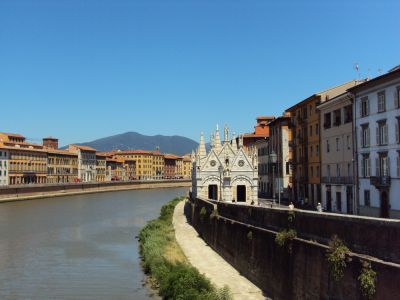“The trouble with Italy,” an Australian tourist said to me recently, “is that there are too many museums and churches.” Of course, she was right, in a way, but can you have too much of a good thing?
Certainly, if you travel to Pisa one of the great things to see is the Campo dei Miracoli, the Field of Miracles, a supremely beautiful cluster of white ecclesiastical buildings which include the famous leaning tower. It is, like St Mark’s Square in Venice, iconic, one of the most crowded urban tourist spaces in Italy, a problem which detracts from the atmosphere, undermining the very thing people have come to see for themselves.
But there is another equally satisfying side to Pisa if, instead of ticking off the leaning tower box and driving away, you stay a while and discover the rest of this small historic city. You can first, for instance, get the flavour by taking a walk along the ramparts above the Campo Santo, the Holy Field or cemetery, looking down on all the lovely buildings.
The centro storico is north of the River Arno, a pleasant area of cobbled streets good for wandering about and finding restaurants and bars. Sooner or later you’ll emerge in the Piazza dei Cavalieri surrounded by fine buildings including Vasari’s Palazzo dei Cavalieri, a masterpiece of sgrafitto work, and next to it the beautiful façade of the church of San Stefano which houses banners captured from Turkish ships in battle. Typically, though, it’s closed. When I asked at the nearby kiosk when it might be open, the woman replied with a shrug, “This is Italy, signora. It is never open.”
In the heat of summer, the Orto Botanico, the oldest botanic gardens in the world, provides a welcome shady oasis.
Right next to the river, looking rather incongruous, is the tiny Chiesa delle Spina, a delicate gothic confection which was built in 1230 to house a thorn from the crown Jesus wore at His crucifixion. Over the years, the church has been altered, making the pinnacles higher, much to the annoyance of John Ruskin who came to Pisa on his Grand Tour and drew the little church. However, I’m sure he wouldn’t have objected to its being raised by one metre to avoid flooding.
Almost opposite is the Palazzo Reale with an important collection of paintings and furniture in lovely frescoed rooms.
Walking along the north bank of the Arno you come to the Museo Nazionale di San Matteo, a former Benedictine convent which now houses an amazing collection of early renaissance works of art, better in my view than the similar collection in the National Gallery in London and worth coming to Pisa for that reason alone. Hardly anyone goes there which seems strange when you consider the masses of tourists a matter of a few hundred yards up the road. For me, the highlights are a Donatello sculpture and works by Simone Martini, Fra Angelico and Masaccio.
If you walk along the river bank in the other direction, you will come to the old Arsenale which is currently being restored and will make a fine exhibition space. Pisa was an important port from Roman times and recently the remains of Roman boats were found here. The nearby Torre Guelfa is a useful medieval landmark, but sadly these days there are weeds growing from the ancient brickwork and no one is allowed inside to climb to the magnificent view from the top.
South of the river, near the station in Piazza Sant’Antonio is a surprising find. Just before he died, Keith Haring painted his last mural here on a gable end. It remained neglected in the bus station for many years, but now the square has been redesigned and you can sit in a café opposite to contemplate his colourful mural.
With so much to see and do it’s a good idea to stay overnight; and where better than the Royal Victoria Hotel (dating from 1837) on the Arno. Still owned and run by the original family, this historic hotel is full of atmosphere with antique furniture and cool high-ceilinged rooms. Many European aristocrats stayed here, often on their Grand Tour, and the list of famous guests is amazing: Dickens, Ruskin, Zola, Scott Fitzgerald, Henry James, Amundsen, Virginia Woolf, Marconi, and Roosevelt, to name but a few. The writing room for guests has mahogany tables with frosted glass screens for privacy and the enamel signs, coat hooks and light fittings are all original.
In Pisa, as in many very famous cities, it is worthwhile to go off the beaten track and explore, getting a feel for the place. Everyone will have seen the leaning tower, but not everyone will have seen the great works of art and architecture and the museums and churches (so disliked by my Australian tourist) or followed in the footsteps of so many famous people.
https://www.lagazzettaitaliana.com/region-of-italy/8273-the-other-pisa#sigProId973b9ce74a
This article first appeared in Italy Magazine.




